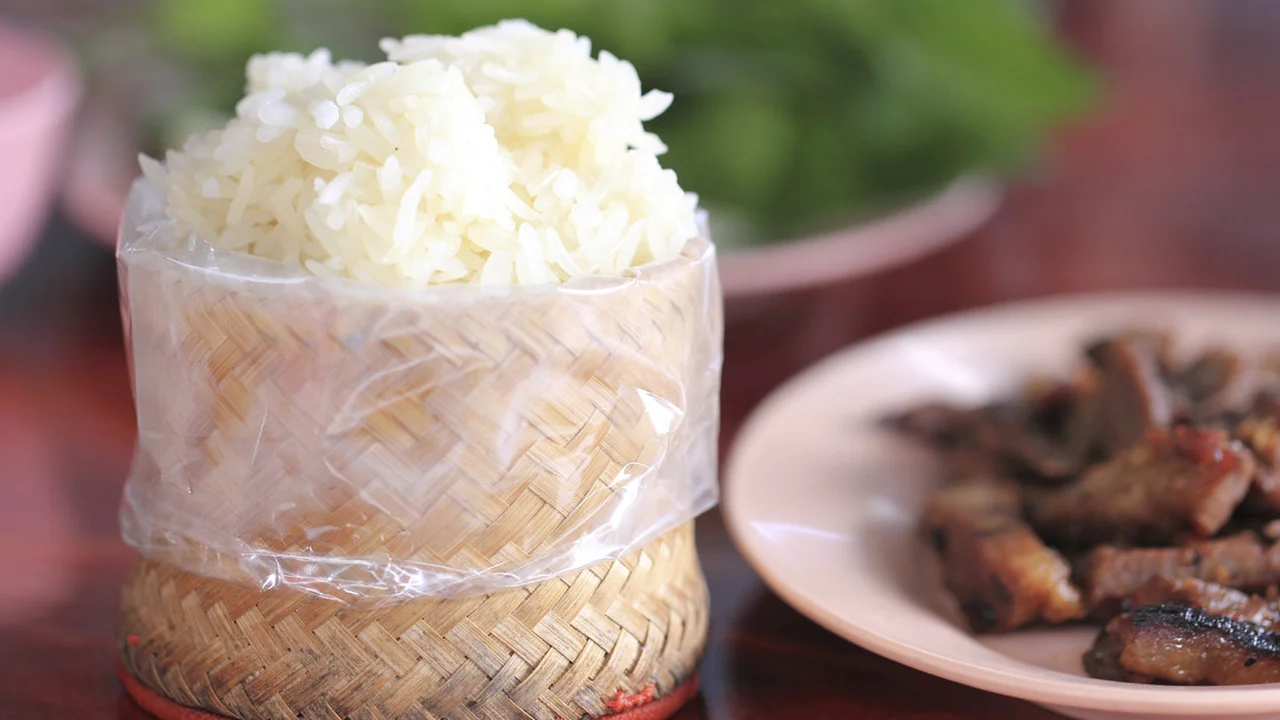Laotian Sticky Rice: A Staple Food

What is Laotian Sticky Rice Khao Niao A Deep Dive into the Heart of Lao Cuisine
Okay, let's talk sticky rice. But not just any sticky rice – we're diving deep into khao niao, the Laotian kind. This isn't your sweet, dessert-y sticky rice. This is the *savory* stuff, the backbone of Lao meals, the thing you eat with, well, pretty much everything. Think of it like bread in the West, but way more fun to eat.
Khao niao, also spelled “kaw niew”, is made from glutinous rice, which sounds scary but just means it gets super sticky and clump-y when cooked. It's steamed, not boiled, which is key to its texture. And that texture? Oh man, it’s chewy, slightly sweet, and incredibly satisfying. You eat it with your hands, forming little balls to scoop up all those delicious Lao dishes. Trust me, once you get the hang of it, you'll be hooked. It's the real deal in Lao comfort food.
The History and Cultural Significance of Sticky Rice A Laotian Tradition
Sticky rice isn't just food in Laos, it's deeply ingrained in the culture. It’s been a staple for centuries, playing a role in everything from daily meals to religious ceremonies. Think about it – entire festivals revolve around sticky rice! It’s a symbol of hospitality, community, and the connection to the land. When you share sticky rice with someone in Laos, you're sharing more than just food; you're sharing a piece of their heritage.
Historically, the cultivation and preparation of sticky rice were community affairs. Everyone pitched in, from planting and harvesting the rice to steaming it in traditional bamboo baskets. While modern technology has made things easier, the spirit of community and tradition still surrounds khao niao. It's a living, breathing part of Laotian identity.
How to Make Laotian Sticky Rice Khao Niao The Authentic Method
Alright, ready to try making your own khao niao? It’s a bit of a process, but totally worth it. Here’s the traditional method:
- Soaking: Soak the glutinous rice in water for at least 4 hours, or preferably overnight. This is crucial for achieving that perfect sticky texture. Use a big bowl and plenty of water.
- Steaming: Drain the rice and place it in a special bamboo steamer called a *houat*. Make sure the water in your pot doesn't touch the rice. Steam for about 30-45 minutes, or until the rice is cooked through and translucent.
- Turning: Halfway through steaming, gently turn the rice to ensure even cooking.
- Serving: Serve immediately in a bamboo basket called a *tip khao*. This keeps the rice warm and allows it to breathe.
Don’t have a bamboo steamer? You can use a regular steamer basket lined with cheesecloth. The key is to make sure the rice doesn’t get waterlogged.
The Perfect Pairings What to Eat with Your Khao Niao
This is where the fun really begins! Khao niao is incredibly versatile and goes with just about everything. Here are some classic Lao pairings:
- Laap: A minced meat salad (chicken, pork, beef, or duck) seasoned with herbs, spices, and toasted rice powder. The toasted rice powder gives it a nutty, slightly crunchy texture. This is a MUST-TRY.
- Sai Oua: Laotian sausage, packed with herbs and spices. It’s often grilled and has a slightly smoky flavor. Perfect for dipping in jeow (Lao dipping sauce).
- Jeow: Speaking of jeow, this is the umbrella term for Lao dipping sauces. There are tons of variations, from spicy tomato jeow to fermented fish jeow. They add a burst of flavor to every bite.
- Grilled Chicken (Ping Gai): Simple, but oh-so-delicious. The chicken is marinated in garlic, lemongrass, and other spices, then grilled to perfection.
- Tam Mak Hoong (Papaya Salad): Similar to Thai papaya salad, but with a unique Lao twist. It’s spicy, sour, and incredibly refreshing.
Seriously, experiment! Khao niao is a blank canvas for flavor. Try it with grilled fish, stir-fries, or even just a simple fried egg.
Khao Niao Beyond the Plate Exploring its Uses in Lao Culture
We've already touched on the cultural significance, but let's dig a little deeper. Khao niao isn't just a meal; it's an offering. It's used in religious ceremonies, given to monks, and presented as gifts. It's also a symbol of good luck and prosperity.
During festivals, you'll often see elaborate khao niao creations, like sticky rice cakes decorated with flowers and fruits. These are beautiful works of art that are both delicious and meaningful.
Where to Find the Best Sticky Rice A Global Guide
If you're lucky enough to visit Laos, you’ll find khao niao everywhere – from street vendors to fancy restaurants. But what if you can't hop on a plane right now? Here are some tips for finding good sticky rice closer to home:
- Look for Lao or Thai restaurants: Many Southeast Asian restaurants serve sticky rice. Ask if they use glutinous rice and steam it in the traditional way.
- Asian grocery stores: You can buy glutinous rice and bamboo steamers at most Asian grocery stores. This is a great option if you want to try making it yourself.
- Online retailers: Several online retailers sell glutinous rice and other Lao ingredients. Just be sure to check the reviews before you buy.
Product Recommendations Elevating Your Sticky Rice Experience
Okay, let's talk products. If you're serious about your khao niao game, here are a few things you might want to invest in:
- Bamboo Steamer (Houat): This is essential for authentic khao niao. Look for one made from high-quality bamboo. A good one will last for years. You can find these on Amazon or at specialty Asian grocery stores. Prices range from $20-$50 depending on size and quality.
- Glutinous Rice: Not all glutinous rice is created equal. Look for brands that are specifically labeled "glutinous rice" or "sweet rice." Avoid brands that are too old or have a musty smell. A 5-pound bag will cost you around $10-$15 at most Asian grocery stores.
- Tip Khao (Sticky Rice Basket): This isn't essential, but it definitely adds to the experience. A traditional tip khao will keep your rice warm and allow it to breathe. You can find these online or at some Asian markets for around $15-$30.
- Electric Rice Cooker with Steaming Function: If you are short on time, or don't want to use a traditional bamboo steamer, an electric rice cooker with a steaming function will do the trick. Look for models with a dedicated "sticky rice" setting for optimal results. Brands like Zojirushi and Tiger are known for their quality, but they can be pricey, ranging from $100-$300. Cheaper alternatives are available for around $50-$80.
Comparing Sticky Rice Products Making Informed Choices
Let's break down some options. When choosing glutinous rice, consider the origin and type. Thai glutinous rice is generally considered to be of high quality, while some Vietnamese varieties can be a bit cheaper. For bamboo steamers, opt for those made from natural bamboo without any chemical treatments. The size of the steamer should match the amount of rice you typically cook. If you're only cooking for one or two people, a smaller steamer will suffice. If you are cooking for a large family, you may want to invest in a larger one.
Electric rice cookers offer convenience, but they may not replicate the exact texture of traditionally steamed khao niao. Look for models with adjustable settings to fine-tune the cooking process. Consider the capacity of the cooker and whether it has additional features like a timer or keep-warm function.
Different Ways to Enjoy Sticky Rice Exploring Various Serving Suggestions
Beyond the classic pairings, get creative! Try using khao niao as a base for stir-fries, or as a side dish for grilled meats. You can even make sweet sticky rice desserts by adding coconut milk, sugar, and fruit. The possibilities are endless!
For a quick and easy snack, try grilling sticky rice cakes. Just slice cooked khao niao into thin patties and grill them until they're crispy and golden brown. Serve with your favorite dipping sauce.
You can also incorporate sticky rice into savory dishes. Mix it with ground pork, herbs, and spices, then stuff it into vegetables like bell peppers or zucchini. Bake until tender and enjoy a flavorful and satisfying meal.
:max_bytes(150000):strip_icc()/277019-baked-pork-chops-with-cream-of-mushroom-soup-DDMFS-beauty-4x3-BG-7505-5762b731cf30447d9cbbbbbf387beafa.jpg)






